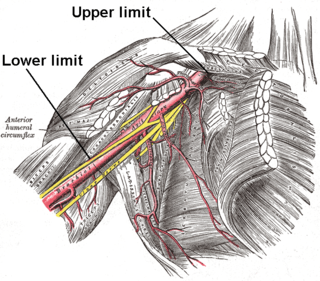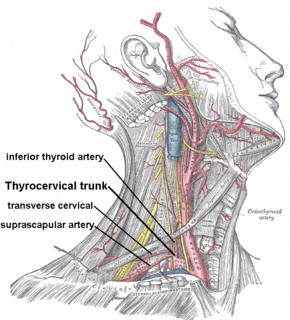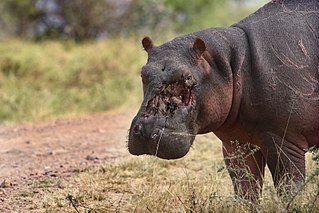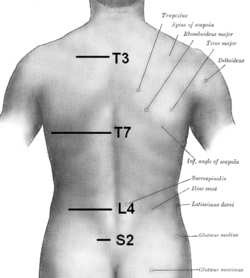
The brachial plexus is a network of nerves formed by the anterior rami of the lower four cervical nerves and first thoracic nerve. This plexus extends from the spinal cord, through the cervicoaxillary canal in the neck, over the first rib, and into the armpit. It supplies afferent and efferent nerve fibers to the chest, shoulder, arm, forearm, and hand.

The dorsal scapular nerve is a branch of the brachial plexus. It supplies rhomboid major muscle, rhomboid minor muscle, and levator scapulae muscle. It causes the scapula to be moved medially towards the vertebral column. Dorsal scapular nerve syndrome can cause a winged scapula, with pain and limited motion.

The long thoracic nerve innervates the serratus anterior muscle.

The levator scapulae is a skeletal muscle situated at the back and side of the neck. As the Latin name suggests, its main function is to lift the scapula.

The suprascapular nerve is a nerve that branches from the upper trunk of the brachial plexus. It is responsible for the innervation of two of the muscles that originate from the scapula, namely the supraspinatus and infraspinatus muscles.

Klumpke's paralysis is a variety of partial palsy of the lower roots of the brachial plexus. The brachial plexus is a network of spinal nerves that originates in the back of the neck, extends through the axilla (armpit), and gives rise to nerves to the upper limb. The paralytic condition is named after Augusta Déjerine-Klumpke.

Erb's palsy is a paralysis of the arm caused by injury to the upper group of the arm's main nerves, specifically the severing of the upper trunk C5–C6 nerves. These form part of the brachial plexus, comprising the ventral rami of spinal nerves C5–C8 and thoracic nerve T1. These injuries arise most commonly, but not exclusively, from shoulder dystocia during a difficult birth. Depending on the nature of the damage, the paralysis can either resolve on its own over a period of months, necessitate rehabilitative therapy, or require surgery.

In human anatomy, the axillary artery is a large blood vessel that conveys oxygenated blood to the lateral aspect of the thorax, the axilla (armpit) and the upper limb. Its origin is at the lateral margin of the first rib, before which it is called the subclavian artery.

A brachial plexus injury (BPI), also known as brachial plexus lesion, is an injury to the brachial plexus, the network of nerves that conducts signals from the spinal cord to the shoulder, arm and hand. These nerves originate in the fifth, sixth, seventh and eighth cervical (C5–C8), and first thoracic (T1) spinal nerves, and innervate the muscles and skin of the chest, shoulder, arm and hand.

The suprascapular artery is a branch of the thyrocervical trunk on the neck.

The supraspinous fossa of the posterior aspect of the scapula is smaller than the infraspinous fossa, concave, smooth, and broader at its vertebral than at its humeral end. Its medial two-thirds give origin to the Supraspinatus.

The great scapular notch is a notch which serves to connect the supraspinous fossa and infraspinous fossa. It lies immediately medial to the attachment of the acromion to the lateral angle of the scapular spine.

The anterior divisions of the lumbar nerves, sacral nerves, and coccygeal nerve form the lumbosacral plexus, the first lumbar nerve being frequently joined by a branch from the twelfth thoracic. For descriptive purposes this plexus is usually divided into three parts:

The axillary spaces are anatomic spaces. through which axillary contents leave the axilla. They consist of the quadrangular space, triangular space, and triangular interval. It is bounded by teres major, teres minor, medial border of the humerus, and long head of triceps brachii.

The cervical spinal nerve 5 (C5) is a spinal nerve of the cervical segment.
Plexopathy is a disorder of the network of nerves in the brachial or lumbosacral plexus. Symptoms include pain, muscle weakness, and sensory deficits (numbness).

In medicine, an avulsion is an injury in which a body structure is torn off by either trauma or surgery. The term most commonly refers to a surface trauma where all layers of the skin have been torn away, exposing the underlying structures. This is similar to an abrasion but more severe, as body parts such as an eyelid or an ear can be partially or fully detached from the body.

Birth trauma refers to damage of the tissues and organs of a newly delivered child, often as a result of physical pressure or trauma during childbirth. The term also encompasses the long term consequences, often of cognitive nature, of damage to the brain or cranium. Medical study of birth trauma dates to the 16th century, and the morphological consequences of mishandled delivery are described in Renaissance-era medical literature. Birth injury occupies a unique area of concern and study in the medical canon. In ICD-10 "birth trauma" occupied 49 individual codes (P10-Р15).
Birth injury refers to damage or injury to the child before, during, or just after the birthing process. "Birth trauma" refers specifically to mechanical damage sustained during delivery.
Crutch paralysis is a form of paralysis which can occur when either the radial nerve or part of the brachial plexus, containing various nerves that innervate sense and motor function to the arm and hand, is under constant pressure, such as by the use of a crutch. This can lead to paralysis of the muscles innervated by the compressed nerve. Generally, crutches that are not adjusted to the correct height can cause the radial nerve to be constantly pushed against the humerus. This can cause any muscle that is innervated by the radial nerve to become partially or fully paralyzed. An example of this is wrist drop, in which the fingers, hand, or wrist is chronically in a flexed position because the radial nerve cannot innervate the extensor muscles due to paralysis. This condition, like other injuries from compressed nerves, normally improves quickly through therapy.













